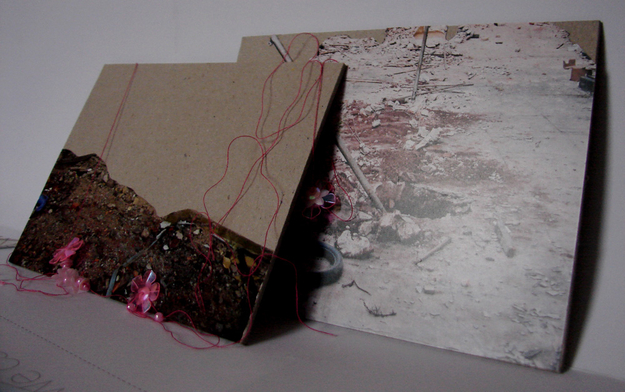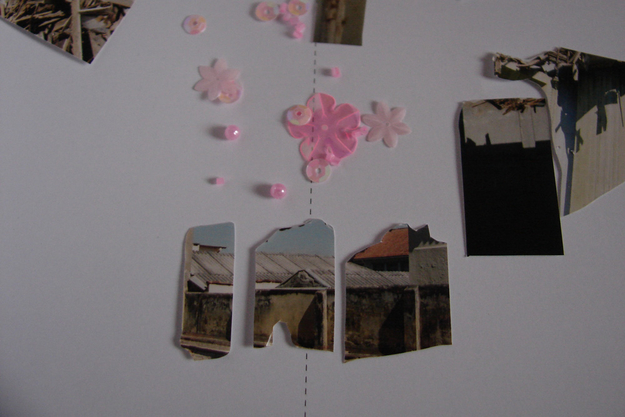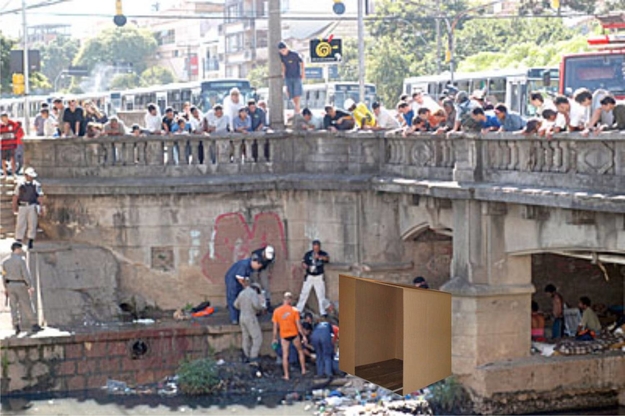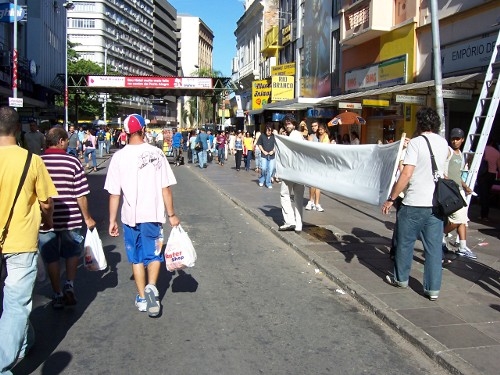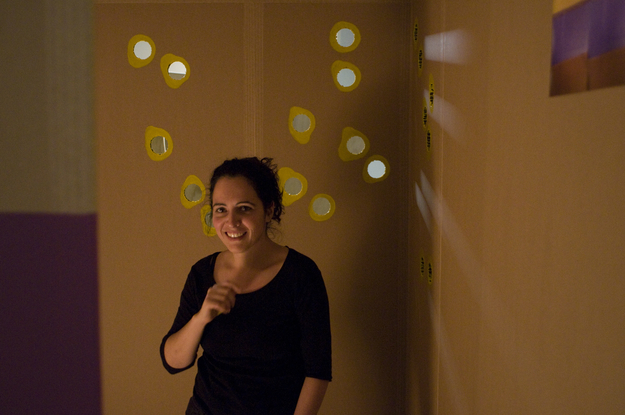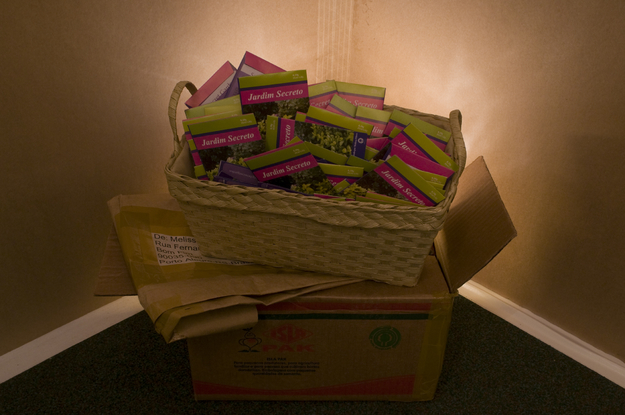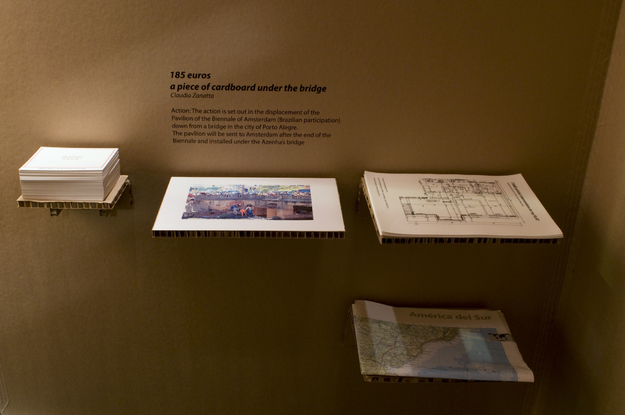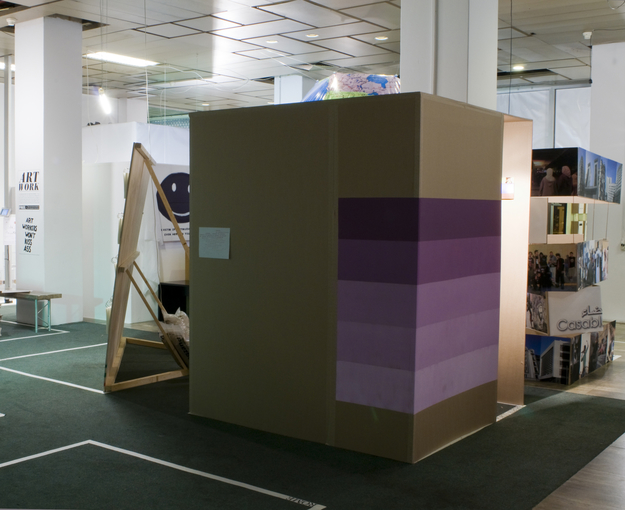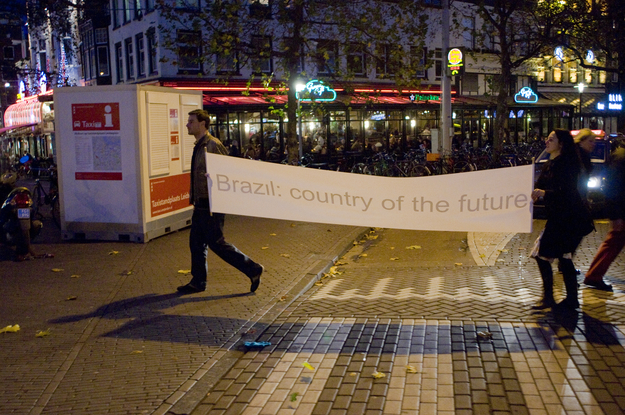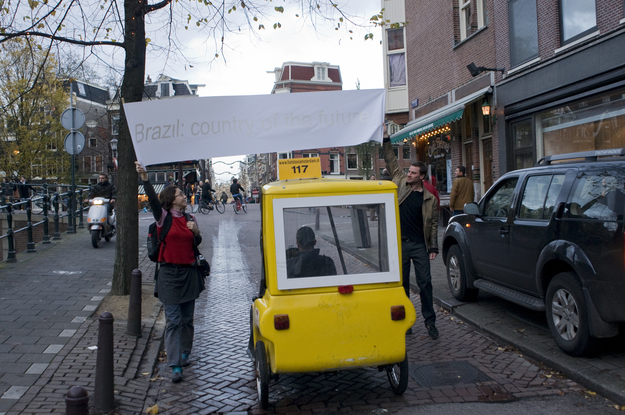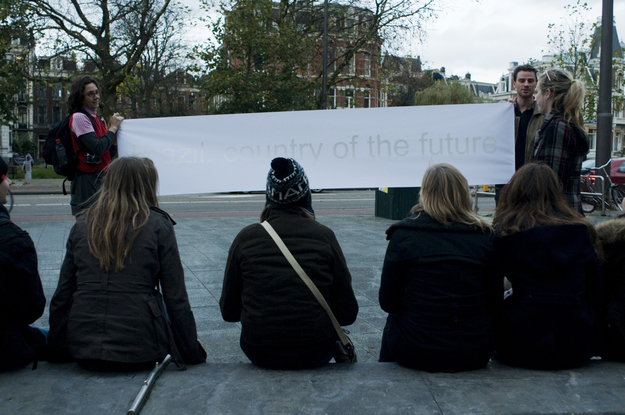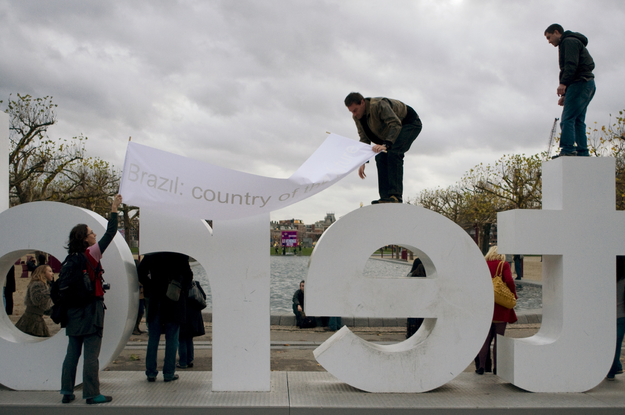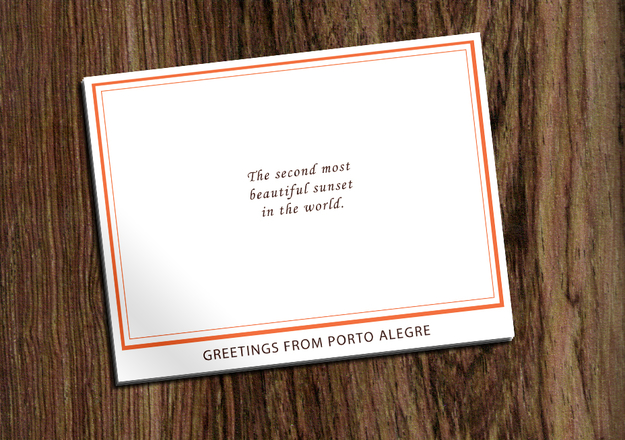Prototype
Cristina Ribas response in occasion to the Pavilion Porto Alegre, Amsterdam Biennial
"Prototype" is the project I'm taking to Amsterdam.
A small box contains photographs and material for cutting and pasting images. Signs are also offered to create conversation sites. In apparent opposition we read "construction site" and "destruction site” and a third one that articulates both in constant motion: " let's be lovers".
The pictures presented show demolished sites, with or without context. The ephemeral situations of conversation, drawing and collage around those images aims to create new landscapes, through what an analysis of a common imagery can be traced. The drawings and collages created by the participants can be donated to the box of images. Those are again new "prototypes"... Participants may also contribute with images of sites destroyed. And sew crystals and beads, flowers and stars within those images.
Protótipos/Prototypes
Decidi voltar para fotografias que realizei em Porto Alegre quase dez anos atrás. O desafio de olhar para elas não é tanto olhar para um passado, mas sentar-se para um momento e investigar como garimpo o que mais há para olhar. Algumas vezes quando as imagens caem nos arquivos parece que cumpriram sua função de morar no presente. E então essa remoção à tona de algo que poderia estar finito de significados pode ser uma força de inversão, extemporânea imagem... As imagens que recentemente se recupera talvez não perteçam a um tempo anterior, tampouco a um tempo futuro. Apresentam lugares em processo de abandono ou destruição estratégica. Porém as imagens são insuficientes em informar o território ao redor. Eu tenho lembranças, mesmo geográficas, dessas locações. Detritos.
. Com minha viagem e a bolsa de residência/pesquisa, não por acaso a paisagem da cidade de Londres me faz insistir novamente nestas imagens. Aqui “construction site” e “destruction site” são muito próximos, articulam-se. E talvez também em outras cidades da Europa, por razões mais ou menos reincidentes e tangentes às de Londres. Em algumas situações a destruição que se contempla ocorre para liberar espaço dentro de cidades estratificadas em uma série ininterrupta de sobreposições de ocupação. Nas cidades contemporâneas os centros se tornam pontos de convergência para fazer crescer novos prédios conectados com a abstração do capital internacional. Essas forças imprimem guindastes nas paisagens.
Então de meu estrangeirismo, preciso olhar as imagens e contextualizá-las. Desvelar os tempos sobrepostos. Mas isso não se pode fazer sozinha. Há uma habitação coletiva que modela essa terra. Dar conta de extirpar uma história que não acompanhei por meu pertencimento longinquio a outras terra seria como carregar ou inundar-se em um bloco pesado de cimento. Impossível, e tampouco desnecessário. Se observo uma paisagem reincidente, me interessa saber como ela habita interstícios de lembrança, como ela reanima sensibilidades e histórias pessoais.
Nos arquivos de Londres estou garimpando imagens de sítios destruídos. E repentinametne me encontrei diante de imagens de escavações arqueológicas. Elas não são parecidas, de alguma forma aos sítios destruídos por demolições sumárias? E as imagens das guerras? Bombardeios.
Pergunto-me então o que faz com que reproduzamos continuamente esta paisagem no imaginário comum? De que forma estas imagens nos afetam, mesmo que sejam ordinárias e dessemelhantes em correspondência direta a nosso imaginário?
Projeto/Caixa
“Protótipo” é o projeto que estou realizando *e que pretendo levar para Amsterdã. Uma pequena caixa contém fotografias e material de corte e colagem. Dois enunciados “construction site” e “destruction site” e uma terceira que as articula num movimento constante: “let’s be lovers”. A partir da caixinha de imagens criam-se situações efêmeras de conversa, desenho e colagem para fazer pensar e experimentar de que forma nos relacionamos com estas paisagens e, talvez, de que forma representamos este imaginário. Os desenhos e colagens criados pelos participantes podem ser doados para a caixinha de imagens, que pode ser tomada como um pequeno arquivo desses “protótipos”. Participantes podem ainda contribuir com imagens de sítios destruídos. E costurar cristais e missangas, flores e estrelas.
185 euros a piece of cardboard under the bridge
Claudia Zanatta proposal in response to her participation in Porto Alegre Pavilion, Biennale Amsterdam
185 euros a piece of cardboard under the Azenha bridge in Porto Alegre
Action: The action is set out in the displacement of the Pavilion of the Biennale of Amsterdam (Brazilian participation) down from a bridge in the city of Porto Alegre. The pavilion will be sent to Amsterdam after the end of the Biennial and installed under the Azenha’s bridge with the help of local residents (people who currently live under a bridge) to be used by themselves as they please.
Da ação: A ação consta no deslocamento do Pavilhão da Bienal de Amsterdam (participação brasileira) para baixo de uma ponte localizada na cidade de Porto Alegre. O pavilhão será enviado de Amsterdam após o término da Bienal e instalado embaixo da Ponte da Azenha com o auxílio de moradores do local (pessoas que atualmente residem embaixo da ponte) para ser utilizado pelos mesmos como bem entenderem.
Montagem realizada pela artista Claudia Zanatta em resposta a sua participação no Pavilhão Porto Alegre, Bienal Amsterdã. Fotografia original: Ricardo Jaeger/Agência RBS/, publicada em ZH, 16.04.2003
++++++Greetings From Porto Alegre
Lucas Levitan response in occasion to the Pavilion Porto Alegre, Amsterdam Biennial
Levitan brings to Amsterdam the project "Greetings From Porto Alegre," which offers an open interpretation of what is considered to be one of the most beautiful sunsets of the world. In order to do so, he presents a postcard with an empty space and a title in its centre "The Second Most Beautiful Sunset In The World".
Levitan doesn’t remember when was the first time he heard this statement, but it has always sounded extravagant to him. How can a sunset be rated as the "second" most beautiful? Or even the "first"? What does it mean?
By omitting the obvious image of Porto Alegre’s sunset in the postcard, Lucas Levitan suggests the spectator to let her imagination fly and reflect on this concept.
